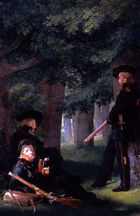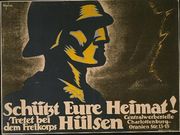Freikorps
The designation of Freikorps (German for "Free Corps") was originally applied to voluntary armies formed in German lands from the middle of the 18th century onwards. After World War I the term was used for the paramilitary organizations that sprang up around Weimar Germany and fought both for and against the state.
Contents |
First Freikorps

The first freikorps were recruited by Frederick II of Prussia in the 18th century during the Seven Years' War. The freikorps were regarded as unreliable by regular armies, so they were mainly used as sentries and for minor duties.
During the Napoleonic Wars, Freikorps were formed for the purpose of shaking off French rule in Germany. Those led by Ferdinand von Schill were decimated in the Battle of Stralsund (1809), many of their members killed in battle or executed at Napoleon's command in the aftermath. Later, Ludwig Adolf Wilhelm von Lützow, a survivor of Schill's freikorps, formed the Lützow Free Corps which took part in the German War of Liberation. The anti-Napoleonic freikorps often operated behind French lines, as a kind of commado or guerrilla force.
Throughout the 19th Century, these anti-Napoleonic freikorps were greatly praised and glorified by German Nationalists, and a heroic myth built up around their exploits. It was this myth which was invoked, in considerably different cirumstances, the aftermath of Germany's defeat in the World War I.
Post-World War I

The meaning of the word "freikorps" changed over time. After 1918, the term was used for the paramilitary organizations that sprang up around Germany as soldiers returned in defeat from World War I. They were the key Weimar paramilitary groups active during that time. Many German veterans felt disconnected from civilian life, and joined a Freikorps in search of stability within a military structure. Others, angry at their sudden, apparently inexplicable defeat, joined up in an effort to put down Communist uprisings or exact some form of revenge (see Dolchstoßlegende). They received considerable support from Minister of Defense Gustav Noske, a member of the Social Democratic Party of Germany, who used them to crush the German Revolution and the Marxist Spartacist League and assassinate Karl Liebknecht and Rosa Luxemburg on 15 January 1919. They were also used to defeat the Bavarian Soviet Republic in 1919.[1]
On 5 May 1919, 12 workers (most of them members of the Social Democratic Party, SPD) were arrested and killed by members of Freikorps Lützow in Perlach near Munich based on a tip from a local cleric saying they were communists. A memorial on Pfanzeltplatz in Munich today commemorates the incident.[2][3][4]
Freikorps also fought in the Baltic, Silesia, and Prussia after the end of World War I, sometimes with significant success.
Though officially 'disbanded' in 1920, many Freikorps attempted, unsuccessfully, to overthrow the government in the Kapp Putsch in March 1920. Their attack was halted when German citizens who were loyal to the state went on strike, cutting off many services, and making daily life so problematic that the Putsch was called off.
In 1920, Adolf Hitler had just begun his political career as the leader of the tiny and as-yet-unknown German Workers Party (soon renamed the National Socialist German Workers Party, NSDAP) in Munich. Numerous future members and leaders of the Nazi Party had served in the Freikorps, including Ernst Röhm, future head of the Sturmabteilung, or SA, and Rudolf Höß, the future Kommandant of the Auschwitz concentration camp.
Hermann Ehrhardt, founder and leader of Marinebrigade Ehrhardt, and his deputy Commander Eberhard Kautter, leaders of the Viking League, refused to help Hitler and Erich von Ludendorff in their Beer Hall Putsch and conspired against them.
Relations with Hitler
Freikorps leaders symbolically gave their old battle flags to Hitler's Sturmabteilung (SA) and Schutzstaffel (SS) on November 9, 1933 in a huge ceremony.[5] Historian Robert Waite claims that Hitler had many problems with the Freikorps. Many of the Freikorps had joined the SA, so when the Night of the Long Knives came, they were among those targeted for killing or arrest, including Ehrhardt and Röhm. He claims that in Hitler's "Röhm Purge" speech to the Reichstag on July 13, 1934, the third group of "pathological enemies of the state" that Hitler lists are, in fact, the Freikorps fighters. Hitler talks of the revolutionaries of 1918, who wanted permanent revolution, hated all authority, and were nihilistic.[6]
Notable Freikorps members
|
|
|
Notable Freikorps
- Freikorps Oberland
- Volunteer Division of Horse Guards (Garde-Kavallerie-Schützendivision)
- murdered Rosa Luxemburg and Karl Liebknecht, Jan 15, 1919 [8]
- led by Captain Pabst [8]
- disbanded on order of Defense Minister Gustav Noske, Jul 7, 1919, after Pabst threatened to kill him [9]
- Freikorps Maercker (Maercker's Volunteer Rifles, or Freiwillige Landesjägerkorps) [10]
- had Reinhard Heydrich as a member [11][12]
- founded by Ludwig Maercker
- Freikorps Roßbach (Rossbach)
- founded by Gerhard Roßbach
- rescued the Iron Division after an extremely long march across Eastern Europe.[13]
- had Rudolph Hoess as a member.
- Marinebrigade Ehrhardt (The Second Naval Brigade)
- Iron Division (Eiserne Division, related to Eiserne Brigade)
- Fought in the Baltic.
- Got trapped in Thorensberg by the Latvian Army. Was rescued by the Rossbach Freikorps.[13]
- Freikorps Lützow
- Occupied Munich following the revolution of April, 1919.
- Commanded by Major Schulz [16]
See also
- Freikorps in the Baltic
- Battle of Annaberg May 1921
References
Bibliography
- Blanke, Richard. Orphans of Versailles: The Germans in Western Poland, 1918-1939, University Press of Kentucky, 1993, ISBN 081311803
- Hoess, Rudolf. Constantine Fitzgibbon, and Primo Levi. Commandant of Auschwitz: The Autobiography of Rudolf Hoess, Sterling Publishing Co., 2000. Translated by Constantine Fitzgibbon, Joachim Neugroschel. ISBN 1842120247, 9781842120248
- Morris, Douglas G. Justice Imperiled: The Anti-Nazi Lawyer Max Hirschberg in Weimar Germany, 2005, University of Michigan Press, ISBN 047211476X
- Mueller, Michael. Canaris, Naval Institute Press, 2007
- Read, Anthony. The Devil's Disciples: Hitler's Inner Circle, W. W. Norton & Company, 2004. ISBN 0393048004, 9780393048001
- Waite, Robert G L. Vanguard of Nazism, 1969, W W Norton & Co
Notes
- ↑ Carlos Caballero Jurado, Ramiro Bujeiro (2001). The German Freikorps 1918-23: 1918-23. Osprey Publishing. ISBN 1841761842.
- ↑ Max Hirschberg & Reinhard Weber. Jude und Demokrat: Erinnerungen eines Münchener Rechtsanwalts 1883 bis 1939.
- ↑ Morris, Justice Imperiled: The Anti-Nazi Lawyer Max Hirschberg in Weimar Germany
- ↑ Freikorps Lützow in the Axis History Factbook
- ↑ Waite, p 197
- ↑ Waite, pg 280-281. See also the full text of the speech at http://members.tripod.com/~Comicism/340713.html
- ↑ Hoess et al., pg 201
- ↑ 8.0 8.1 Waite, pg 62
- ↑ Waite, pg 145
- ↑ Waite, pg 33-37
- ↑ "Axis History Factbook". http://www.axishistory.com/index.php?id=5788. Retrieved 2009 1 3.
- ↑ Mueller, p 61
- ↑ 13.0 13.1 Waite, pg 131, 132
- ↑ Waite, pg 140-142
- ↑ Waite, pg 203, 216
- ↑ Waite, pg 89
External links
- Axis History Factbook; Freikorps section – By Marcus Wendel and contributors; site also contains an apolitical forum
- Freikorps Master list on Axis History Forum {reference only}